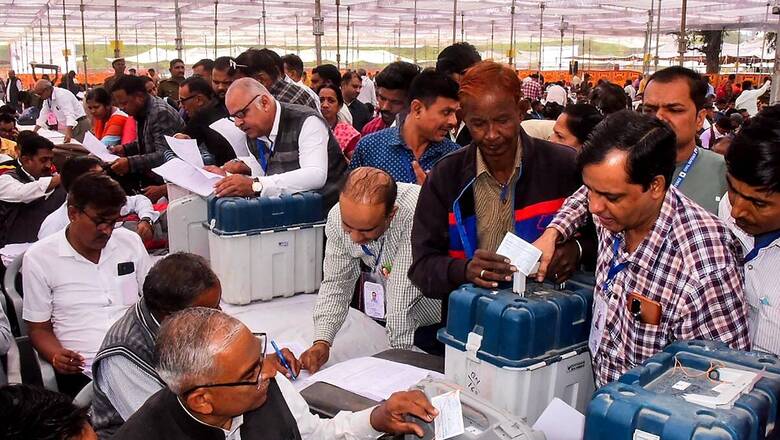
views
“The will of the people shall be the authority of the government; this will shall be expressed in periodic and genuine elections which shall be by universal and equal suffrage and shall be held by secret vote or by equivalent free voting procedures” – Article 21, Universal Declaration of Human Rights 1948
In India, the will of the people is expressed through elections, which symbolise the celebration of our vibrant democracy. Despite being surrounded by regions plagued by dictatorships and communist influences, India stands as a beacon of hope. However, the frequent occurrence of elections has placed a significant strain on the functioning of our governments. The constant cycle of intermittent and by-elections has resulted in a substantial waste of resources.
It is estimated that five elections take place annually for state legislative assemblies in India. When factoring in the additional by-elections and elections for local self-governing institutions, the financial and manpower requirements become overwhelming. This diversion of resources halts development works as the focus shifts towards election activities. In 2019 alone, the Election Commission of India (ECI) utilised the services of approximately 70 lakh personnel to oversee the election process at over 12 lakh polling stations nationwide. Many of these personnel are drawn from central civil services, autonomous bodies, public sector undertakings, and state civil services. This reliance on external resources often leads to administrative paralysis, bringing the state’s economy to a standstill. It is at this critical juncture that the concept of ‘One Nation, One Election’ necessitates unanimous approval from the people of our nation.
The Indian government established a high-level committee to address the issue of simultaneous elections through a notification. This initiative was a significant electoral promise made by the BJP, pledging to explore the feasibility of holding simultaneous polls nationwide once in power. Simultaneous elections were a common practice in India until 1967, with national and state assemblies synchronising their electoral cycles during the years 1951-52, 1957, 1962, and 1967. However, this practice was discontinued after the dissolution of multiple state assemblies in 1968 and 1969, following the imposition of Article 356 of the Constitution, which placed all state machinery under the Central government’s control.
Subsequently, due to variations in the tenures of different assemblies, elections have been held almost every year in the country. The frequent use of Article 356 to intervene in state governments has disrupted the political landscape, with the provision being invoked 110 times between 1952 and 2010.
Numerous commissions and committees have consistently called for the implementation of simultaneous elections throughout India. In its inaugural annual report in 1983, the ECI proposed the idea of conducting simultaneous elections for both the House of the People and the State Legislative Assemblies. The Law Commission of India thoroughly examined the various issues related to conducting elections and, in its reports of 1999, 2015, and 2018 (draft), recommended the adoption of simultaneous elections to relieve citizens, political parties, and government authorities from the burden of asynchronous elections. In 2002, the National Commission to review the working of the Constitution (NCRWC) acknowledged the drawbacks of separate elections and advocated for the reinstatement of simultaneous elections.
Many foreign countries follow a simultaneous election system. In South Africa, elections are held every five years for various levels of government, such as the national and provincial assemblies, along with municipal councils. In Sweden, county and municipal councils have elections every four years in conjunction with general elections, while municipal assemblies are elected every five years. Belgium conducts federal elections every five years, which align with European elections. Similarly, in the United States, the timing of elections for the President, Congress, and local levels are coordinated.
The Department-related Parliamentary Standing Committee on Personnel, Public Grievances, Law and Justice conducted a comprehensive study on the issues involved in holding elections in 2015 and recommended that simultaneous elections would be necessary to facilitate India’s progress towards high economic development.
The Committee recommended amending Article 83 as the initial step towards achieving simultaneous elections. Once this amendment is made, the terms of all legislative assemblies formed after the House of People elections will be co-terminus with the House of People’s term. This implies that following the specified date set by the President of India, state assembly terms will end concurrently with the House of People’s term. The second step involves aligning elections for local self-governing institutions with those of the House of the People and state legislative assemblies. Municipalities and panchayat elections should be conducted within 100 days of the House of the People and state legislative assembly elections.
Amendments were also proposed for the duration of legislative assemblies in Delhi, Puducherry, and Jammu and Kashmir. If a House is dissolved due to a pending no-confidence motion or unforeseen circumstances, fresh elections will only be held for the remaining term of the previous House of the People. To implement these reforms, a single electoral roll for all elections across the country was suggested.
The report by the high-level committee, if executed, will be a significant decision that will result in rapid changes in our economy. The Election Commission estimates that over Rs 4500 crore is being spent on elections. This initiative will not only bring economic progress but also ensure social and political advancements. The practice of distributing freebies will come to a stop, and people will shift their focus towards development. The announcement of the 2024 polls can be viewed as a precursor to this reform, as assembly elections in four state assemblies and 26 constituency by-elections have been synchronised with the Lok Sabha polls.
This conveys the message that the commission is prepared to implement such a major reform in our electoral system. Once implemented, this reform will undoubtedly lead to an increase in voter turnout. The sooner we implement ‘One Nation, One Election,’ the sooner we will realise our vision of ‘Viksit Bharat.’
Adarsh Kuniyillam is a Parliamentary, policy and political analyst from Kerala and has supported various Members of Parliament in Parliamentary works. Views expressed in the above piece are personal and solely that of the author. They do not necessarily reflect News18’s views.



















Comments
0 comment